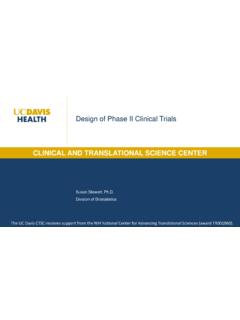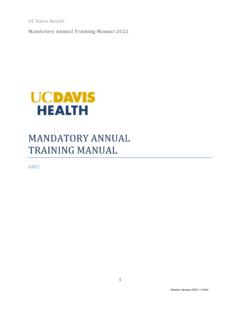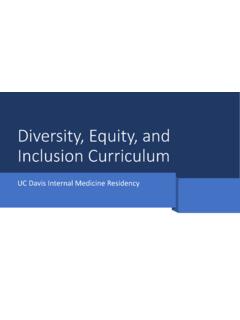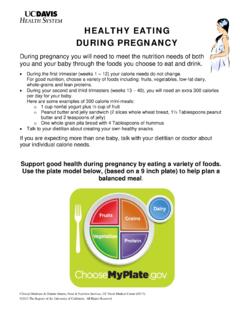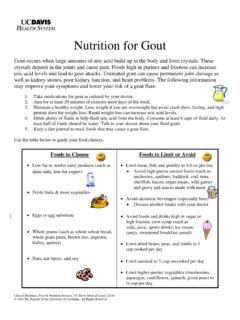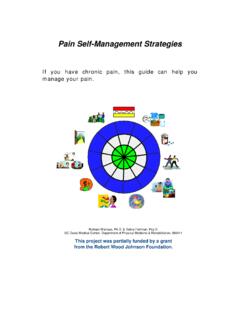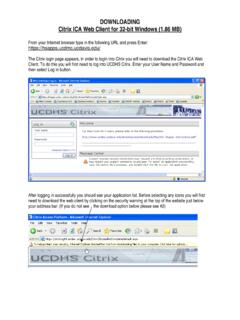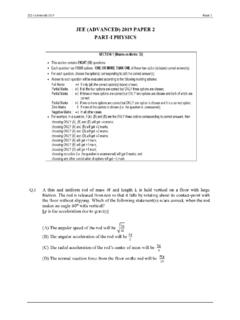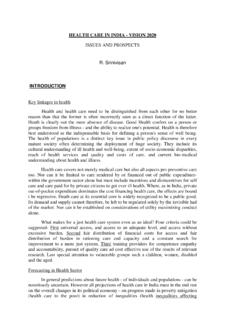Transcription of HealthCare Provider CPR Guidelines - UC Davis
1 HealthCare Provider CPR Guidelines The American Heart Association s New 2020 Guideline Changes are highlighted in yellow 10/21/2020 1 | Page ADULT CPR STEPS STEP ACTION Make sure the scene is safe Check Responsiveness: Tap victim s Shoulder and shout, Are you Ok? Activate Emergency Response system: Depending on your situation: Phone 911 or Call a Code and get an AED If someone comes to help you, have that person call 911 and get an AED. If you are alone and have a cell phone, call 911 and put the phone on speaker and get an AED if available. If you are alone and do not have a cell phone, leave the person to call 911 and get an AED if available. Return to the person. Use the AED as soon as you have it. Check for breathing Look from head to chest to see if the person is breathing Do this for at least 5 seconds but no more than 10.
2 If the person is unresponsive and isn t breathing normally or is only gasping then START CPR. Check Pulse: Palpate a carotid pulse If you do not feel a pulse within 10 seconds, begin high-quality CPR, starting with chest compressions. Give 30 Compressions Make sure the person is lying on his back on a firm flat surface. Move clothes out of the way. If a person s clothes are difficult to remove, you can still provide compressions over clothing. Put the heel of one hand on the lower half of the breastbone. Put the heel of your other hand on top of the first hand. Compress at least 2 inches at a rate of 100 to 120 compressions per minute. Do not compress deeper than inches in adults as it may cause injuries After each compression, allow complete chest recoil. Open the airway and give breaths Provide effective breaths: open the victim s airway.
3 Use the appropriate technique to open the airway Head Tilt-Chin Lift: tilt the head back and lift the chin to open the airway Jaw Thrust: If a head or neck injury is suspected HealthCare Provider CPR Guidelines The American Heart Association s New 2020 Guideline Changes are highlighted in yellow 10/21/2020 2 | Page ADULT CPR STEPS STEP ACTION Deliver each rescue breath over 1 second The victim s chest should rise with each breath Open the airway and give breaths- continued Avoid excessive ventilation Use bag-valve mask or barrier device if available Once an advanced airway is placed, continuous compressions are performed without pause for ventilation. Ventilations are delivered at a rate of 1 breath every 6 seconds. If there is a pulse and the victim is not breathing: Provide rescue breathing: 1 breath every 6 seconds (10breaths/minute) Continue sets of compressions and breaths Continue giving sets of 30 compression and 2 breaths until help arrives or the person becomes responsive.
4 In two-person CPR the rescuers should change positions after every 2 minutes Ratio stays the same for one-person & two-person CPR Use the AED as soon as you have it. AED STEPS STEP ACTION Turn on the AED Remove all clothing that covers the chest. AED pads must not be placed over any clothing. Follow the prompts, which will tell you everything you need to do. Attach the pads Adult pads: Use adult pads for person 8 years and older Child pads Use child pads if the child is less than 8 years old. If child pads are not available use adult pads. Peel away the backing from the pads. Follow the pictures on the pads, attach them to the person s bare chest. Make sure the pads don t touch each other. Let the AED check the heart rhythm Loudly state, CLEAR and make sure that no one is touching the person.
5 The AED will check the heart rhythm. If a shock is not needed, resume CPR. Clear and deliver a shock if needed Loudly state, CLEAR and make sure that no one is touching the person. Push the SHOCK button. Immediately resume CPR. HealthCare Provider CPR Guidelines The American Heart Association s New 2020 Guideline Changes are highlighted in yellow 10/21/2020 3 | Page CHILD CPR STEPS STEP ACTION Make sure the scene is safe Check Responsiveness: Tap child s Shoulder and shout, Are you Ok? Activate Emergency Response system: Depending on your situation: Phone 911 or Call a Code and get an AED Witnessed Arrest: If you are alone with no mobile phone, leave the child to activate the emergency response system and get the AED before beginning CPR. Otherwise, send someone and begin CPR immediately: use the AED as soon as it is available Unwitnessed Arrest: Give 2 minutes of CPR Leave the child to activate the emergency response system and get the AED Return to the child and resume CPR: use the AED as soon as it is available If someone comes to help you, have that person call 911 and get an AED.
6 If you are alone and have a cell phone, call 911 and put the phone on speaker and get an AED if available. Use the AED as soon as you have it. Check for breathing Look from head to chest to see if the person is breathing Do this for at least 5 seconds but no more than 10. If the child is unresponsive and isn t breathing normally or is only gasping then START CPR. Check Pulse: Palpate a carotid pulse If you do not feel a pulse within 10 seconds, begin high-quality CPR, starting with chest compressions. Give 30 Compressions Make sure the child is lying on his back on a firm flat surface. Move clothes out of the way. If a person s clothes are difficult to remove, you can still provide compressions over clothing. You may use either 1 or 2 hands for chest compressions Compress at least 1/3 the depth of the chest about 2 inches at a rate of 100 to 120 compressions per minute.
7 After each compression, allow complete chest recoil. HealthCare Provider CPR Guidelines The American Heart Association s New 2020 Guideline Changes are highlighted in yellow 10/21/2020 4 | Page CHILD CPR STEPS STEP ACTION Open the airway and give breaths Provide effective breaths: open the child s airway. Use the appropriate technique to open the airway Head Tilt-Chin Lift: tilt the head back and lift the chin to open the airway Jaw Thrust: If a head or neck injury is suspected Deliver each rescue breath over 1 second The child s chest should rise with each breath Avoid excessive ventilation Use bag-valve mask or barrier device if available Once an advanced airway is placed, continuous compressions are performed without pause for ventilation. Ventilations are delivered at a rate of 1 breath every 2-3 seconds (20-30 breaths/minute) If there is a pulse >60 per minute and inadequate breathing: Provide rescue breathing: 1 breath every 2-3 seconds (20-30 breaths/minute) Continue sets of compressions and breaths Continue giving sets of 30 compression and 2 breaths until help arrives or the person becomes responsive.
8 In two-person CPR the rescuers should change positions after every 2 minutes Ratio changes for two-person CPR to 15 compressions to 2 breaths Use the AED as soon as you have it. HealthCare Provider CPR Guidelines The American Heart Association s New 2020 Guideline Changes are highlighted in yellow 10/21/2020 5 | Page Infant CPR STEPS STEP ACTION Make sure the scene is safe Check Responsiveness: Tap infant s heel of foot and shout, Are you Ok? Activate Emergency Response system: Depending on your situation: Phone 911 or Call a Code and get an AED Witnessed Arrest: If you are alone with no mobile phone, leave the victim to activate the emergency response system and get the AED before beginning CPR. Otherwise, send someone and begin CPR immediately: use the AED as soon as it is available Unwitnessed Arrest: Give 2 minutes of CPR Leave the child to activate the emergency response system and get the AED Return to the infant and resume CPR: use the AED as soon as it is available If someone comes to help you, have that person call 911 and get an AED.
9 If you are alone and have a cell phone, call 911 and put the phone on speaker and get an AED if available. Use the AED as soon as you have it. Check for breathing Look from head to chest to see if the person is breathing Do this for at least 5 seconds but no more than 10. If the infant is unresponsive and isn t breathing normally or is only gasping then START CPR. Check Pulse: Palpate a brachial pulse If you do not feel a pulse within 10 seconds, begin high-quality CPR, starting with chest compressions. Give 30 Compressions Make sure the infant is lying on his back on a firm flat surface. Move clothes out of the way. Compress at least 1/3 the depth of the chest about 1 1/2 inches at a rate of 100 to 120 compressions per minute CPR ratio for one-person CPR is 30 compressions to 2 breaths Single rescuer: use 2 fingers, 2 thumb-encircling technique or the heel of 1 hand.
10 HealthCare Provider CPR Guidelines The American Heart Association s New 2020 Guideline Changes are highlighted in yellow 10/21/2020 6 | Page Infant CPR STEPS STEP ACTION CPR ratio for two-person CPR is 15 compressions to 2 breaths Use 2 Thumb-Encircling technique for compressions After each compression, allow complete chest recoil. Open the airway and give breaths Provide effective breaths: open the infant s airway. Use the appropriate technique to open the airway Head Tilt-Chin Lift: tilt the head back and lift the chin to open the airway Deliver each rescue breath over 1 second The infant s chest should rise with each breath Avoid excessive ventilation Use bag-valve mask or barrier device if available Once an advanced airway is placed, continuous compressions are performed without pause for ventilation.
